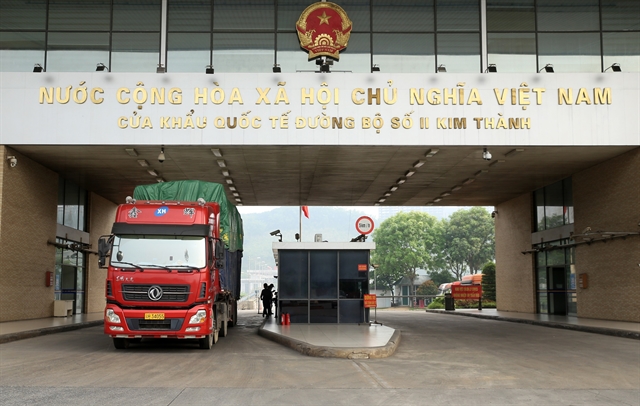 Economy
Economy

 |
| Kim Thành Road No 2 International border gate, Lào Cai Province. Vietnamese firms need to improve product quality and design while lowering costs to increase competitiveness and the export of agricultural products to China. — VNA/VNS Photo Quốc Khánh |
HÀ NỘI — China’s reopening of borders after nearly three years of lockdowns to combat the COVID-19 pandemic is good news for Việt Nam to increase the export of agricultural products.
However, there were also challenges ahead, Minister of Agriculture and Rural Development Trần Thanh Nam said.
Nam was speaking at an online conference about promoting trade of agricultural and food products between Việt Nam and Yunnan (China) on Friday after China started a round-trip freight train route between China – Laos – Thailand on February 7. The route helped shorten the travel time by about 24 hours while reducing the transportation cost by more than 20 per cent.
Nam said that this was creating pressure on Việt Nam in the competition of exporting to China with Thailand. “This challenge was forcing Vietnamese firms to improve product quality and design while lowering costs to increase the competitiveness and boost agricultural exports to China,” Nam said.
Lê Thanh Hòa, deputy director of the Agro Processing and Market Development Authority, said that China was a huge consumption market that imported more than US$260 billion a year. However, Việt Nam’s exports to China remained modest, accounting for just below 5 per cent of China’s imports.
Hòa said that the Ministry of Agriculture and Rural Development was working with China’s General Administration of Customs to facilitate trade and continue negotiations for the official export of agricultural products such as grapefruit, avocado, custard apple, water apple, cardamom and pineapple.
Hòa said that it was necessary to improve the connectivity of the Hà Nội – Lào Cai railway with sea and land routes from ASEAN countries to promote exports to China via border gates.
Tô Ngọc Sơn, deputy director of the Asia – Africa Market Department under the Ministry of Industry and Trade, said Vietnamese enterprises must be aware that China was a market with high requirements.
“It is necessary to reduce dependence on and then stop exports through unofficial channels with a strong transition to formal trade. New market trends must be updated together with the production of high-quality products,” he said. “The focus must be placed on building and protecting brands.”
In addition, there was an increasing trend of trade via e-commerce channels with China, and “it’s a trend of the future,” he said, adding that e-commerce was a potential channel to expand markets.
According to Nam, Yunnan remained a largely untapped potential market, especially for seafood products. Currently, Việt Nam exported seafood products to China mainly through Móng Cái.
Each province of China was a huge market, thus, it was necessary to enhance cooperation to obtain market information of each province, he said.
According to Nam, preparations must be geared up for the granting of codes for plantation areas and packaging facilities to increase the official export of agricultural products to China.
Currently, 16 plant products are being exported to China, including banana, durian, mangosteen, black jelly, rice bran, rice, sweet potatoes, watermelon, dragon fruit, mango, jackfruit, longan, lychee, rambutan, chili and passion fruit. Of them, seven products had protocols.
To date, China granted 2,492 codes for Việt Nam’s export enterprises, 2,000 codes for plantation areas and 1,438 codes for packaging facilities for export to China. — VNS




